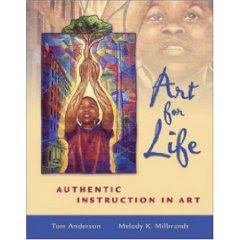Art Education in a Post-Modern Age
Author(s): Michael E. Parks
Source: Art Education, Vol. 42, No. 2 (Mar., 1989), pp. 10-13
Published by: National Art Education Association
Stable URL: http://www.jstor.org/stable/3193128
Accessed: 08/09/2009 14:10
Modernism Becomes the Establishment
“…formalism became the measure of quality; a work was judged not for its relevance to external concerns, but on the basis of aesthetic coherence within the work itself.”
Industrialization vs. Computerization
“…art becomes pluralistic and diverse, acknowledging the ambiguousness of the present and future, while reinterpreting contemporary life by reflecting on the look of "old" art. It rejects formalism as a standard of measure, relying instead on allegory, metaphor, narration, and the juxtaposition of seemingly unrelated images.”
Post-Modernism and Its Critics
“The most vocal critics, however, have targeted the art establishment as a primary source of concern, the proliferation of dealers who select work based on what is marketable rather than on what is good, fostering the idea that art is a commodity, and the museums with their corporately-financed extravaganzas, exhibiting work that is pleasing to the eye, but devoid of anything controversial or particularly thought-provoking.”
Implications for Art Education
Criticism
“The new work is richly endowed with appropriated styles and subject matter, visual metaphor, allegory, and narrative imagery.”
History
“Where Modem artists totally rejected the past, Post-Modem artists have seemingly embraced it.”
Aesthetics
“During the Modem era, the judgment of quality and truth rested on the formal principles of symmetry and closure.”
“Today, artists frequently ignore such concerns, and in some cases deliberately create "bad" art - works that deliberately break accepted rules of composition and taste.”
Conclusion
“The Discipline Based Art Education (DBAE) approach to teaching has parallels with current trends in art. It shifts the emphasis from art as a tool for nurturing self-expression, to art as a subject worthy of study.”
“To understand post-modem art, a viewer needs the kind of background that the DBAE approach provides.”
Subscribe to:
Post Comments (Atom)






No comments:
Post a Comment